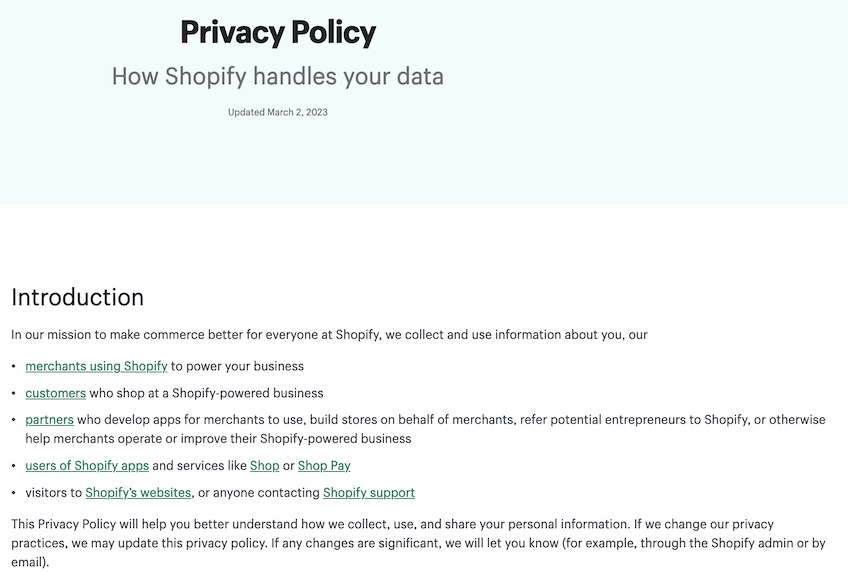
Disclosure: Our content is reader-supported, which means we earn commissions from links on Quick Sprout. Commissions do not affect our editorial evaluations or opinions.
Website privacy policies may not be the hottest topic in the business world—or any world for that matter—but if you’re a website owner, you should at least be aware of them and what they do.
A website privacy policy is a document that tells visiting users how the website will collect, store, and use whatever personal information they share with it.
By law, any website that collects user data is required to have a privacy policy. However, despite how it’s an obligation, it can also be an opportunity. That’s because having a credible privacy policy can also create transparency and build trust among users.
If you own or are planning to build a website, the answer to the above question is probably you.
Every website collects personal information. Even if you’re not collecting obvious personal details like names or email addresses, you’re still receiving traffic with other information like IP addresses.
If you plan to use third-party apps from companies like Google, Meta, and Apple on your website, you’ll need a privacy policy to stay compliant while you use their services.
As for the public sector, no overarching federal law in the United States applies to internet privacy policies, but a collection of federal, state, and international regulations requires anyone who owns a website to have a privacy policy.
Here’s an overview of the internet privacy laws that require U.S. website owners to have privacy policies in place:
Not having a privacy policy displayed on your site can have major consequences.
First of all, privacy disputes can erode customer trust, disrupt sales cycles, and lead to negative media coverage.
Second, if someone discovers you’ve collected data or shared their information without their knowledge, that person has the right to lawyer up and take you to court for damages.
And then there’s the matter of fines for violating the above laws. Penalties can start at $2,500 each time a California resident downloads an application that’s not compliant with CalOPPA. These penalties can reach up to $20 million or four percent of your annual revenue for violations of the GDPR.
The privacy and data protection landscape is complex. Your policy must be comprehensive to protect your business, and it should answer a lot of questions to ensure you’re compliant.
The first thing to include is a title and an introduction. Begin by sharing the document’s purpose and inform users how you collect, use, and protect their personal information.
Provide a name and address to identify your organization, and be sure to include contact information. Then let people know the scope of the policy and to whom it applies.
If you want to see one in action, Shopify’s privacy policy does a great job at handling the introduction.

The first clause in your privacy policy should outline all the personal data your website gathers from users. Be as thorough as possible in this section.
You’ll need to do a full review of your website to ensure you understand all the data collection points. Your review should include:
Doing this kind of review will ensure you’re basing your privacy policy on your actual data collection practices. It also shows you’re taking a proactive approach to maintain compliance with privacy laws.
In this section, you need to tell people how you plan to collect their data.
Here are some examples of common data collection points and how to address them in your policy:
To comply with laws like GDPR, your privacy policy must state your legal purpose for collecting user data.
This applies to each category of data you collect. You’ll need to provide a clear and specific explanation for why collecting that kind of data is essential—along with your legal basis for gathering it.
Including this information ensures data is collected and processed transparently and equitably.
If you want to see how it’s done in the wild, take a look at Spotify’s privacy policy.

It’s important to have a section that explains how and why you will use the personal data you collect. This creates transparency and shows how your practices align with legal requirements for privacy.
It’s also a best practice to organize this section in a table format—it’s well-structured and easy to read.

To comply with legislations like GDPR and CCPA, you should let users know if you share or sell their personal information to third parties. This could include partners, advertisers, or additional service providers.
This clause should clearly explain when—and under which circumstances—you share personal data with anyone outside of your organization.
Structure this section so it’s easy to sort through. You can use bullet points, lists, and outlines to categorize both the types of data you share and your purposes for sharing them.
Here’s an example of how this could look:
Also be sure to let users know you need their consent to share data, and show them how they can manage their consent preferences.
Whether or not your website is aimed at younger audiences, you must include a clause addressing child privacy concerns to comply with COPPA.
Here’s an outline of what you need to include in this section:

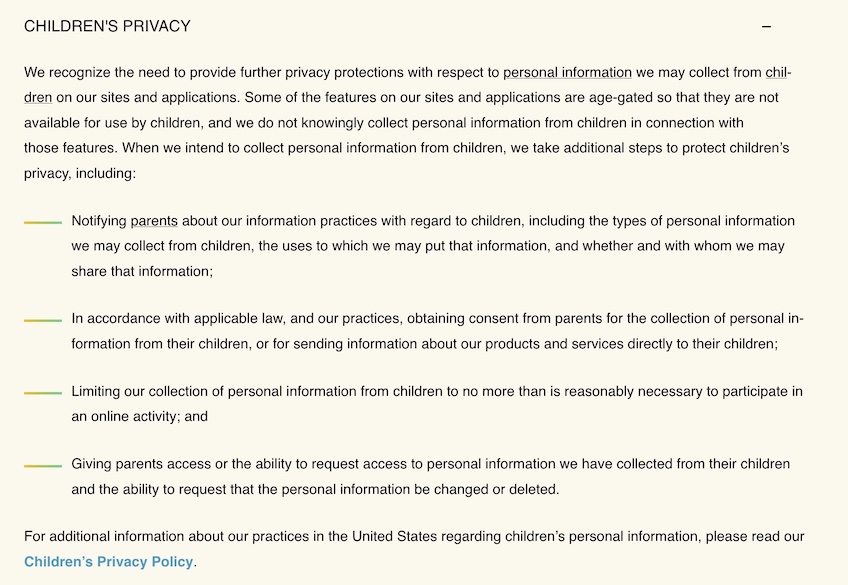
Various state laws require website owners to tell users their rights regarding their data. That means you must include a clause with these details in your privacy policy.
It’s essential to include all the personal information you collect and any third parties who might access it. You also need to clearly highlight which states and laws the policy covers.
A great example of this type of clause can be found in Shopify’s privacy policy.
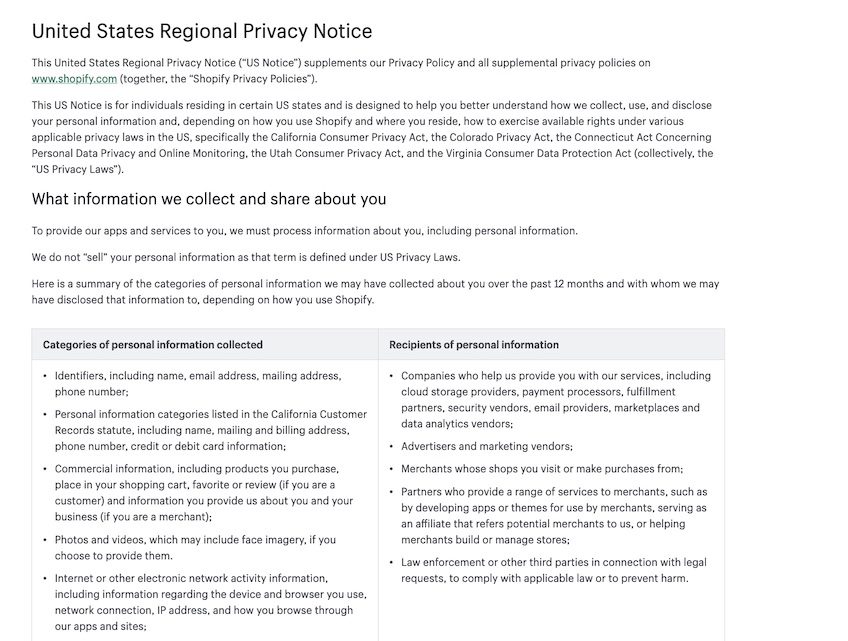
To comply with laws like GDPR and CCPA, your privacy policy needs to let users view your collected data and control access to that data.
Language in this clause should focus on empowering users by letting them exercise their right to access the data you’ve collected. It should communicate what users can expect when they exercise this right, what kinds of data they can ask to view, and how they can request access to their data.
It’s also important to share how long it will take to provide the requested information and the format in which they’ll receive it.
Be sure to emphasize that users won’t face discrimination or adverse treatment by exercising their right to access this information.
As a website owner, you’re responsible for the safety and security of user data. That means protecting it from things like data breaches and security threats.
As such, your privacy policy should include a clause that informs users of the security measures you have in place and your commitment to protecting their personal information.
You’ll find a good example of this clause in the privacy policy from Netflix.

Some data privacy laws, like the GDPR and Virginia’s Consumer Data Protection Act, include specific requirements for user data retention.
You’ll need a clause outlining these legal obligations and information on how you comply with them.
Meta’s privacy policy provides a good example of how to write this section effectively.
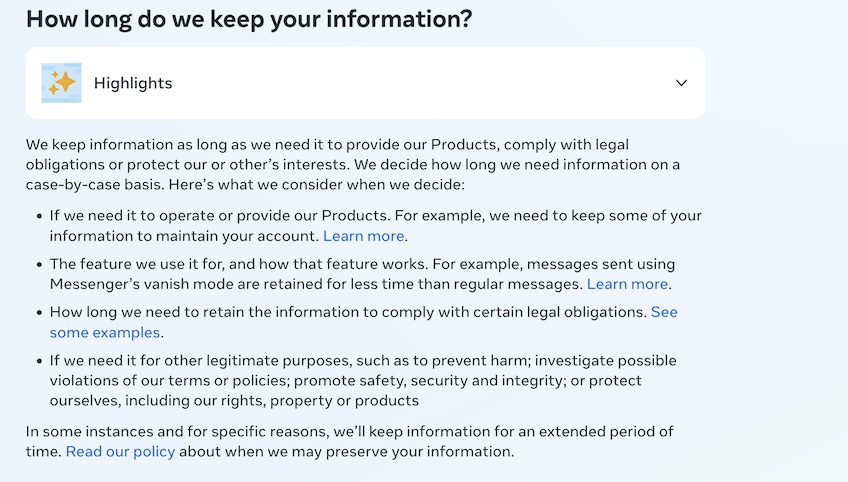
Many websites use cookies, pixels, and other technologies to track user behavior. The GDPR and CCPA classify these as personal data. So, if you use cookies on your website, you must cover it in your privacy policy.
This section of your privacy policy should include:
Some websites also create a separate cookie policy and link it to their general privacy statement to keep it concise.
Internet privacy laws like CPRA and CCPA mandate website owners to update their privacy policies annually and let users know how they’ll communicate updates.
Policies might also need updating to reflect changing company practices, changes in privacy laws, and new regulations.
You’ll need to create a separate clause in your privacy policy to cover this. You can keep this one simple, like the privacy policy from X/Twitter.
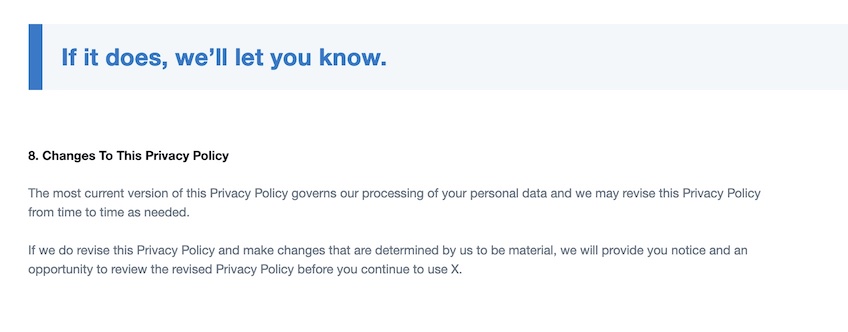
If you have any other key policy documents related to your business, it’s a best practice to link to them in your privacy policy.
These documents can include terms of service, cookie policies, and any other disclaimers or warnings.
Putting these in your policy will increase transparency with your users and lead to a better user experience. This helps maintain trust and brand loyalty.
If your organization transfers data over international borders, you need a clause in your privacy stating it so you can comply with the GDPR.

If you plan to sell all or part of your business in the future, you should include a business clause in your privacy policy.
A business clause tells users what will happen to their data if you sell your business. This often means letting them know how you’ll share data with the new owner.
This is a proactive step to reduce potential liabilities and be ultra transparent.
It’s critical that you let people know how to contact you with questions and concerns about your policy.
Include the email address of someone responsible for administering the policy and a mailing address for your business.
Writing an internet privacy policy is a big job that needs to be taken seriously. You’re creating a legal disclosure document to stay compliant with tons of laws.
With documents like these, it’s advisable to have a lawyer prepare them or at least review what you’ve written.
That said, it may not be very affordable or feasible for every website owner to hire a lawyer for their privacy policy.
Luckily, some companies offer templates and privacy policy generators that you can often use for free:
Whether you want to work with a website designer or do it yourself, there are several options, locations, and techniques for adding your privacy policy to your website. However, most sites will follow a certain standard when it comes to each one.

Along with being comprehensive enough to cover all the legal bases, your privacy policy should also be easy for users to read and navigate.
You’ll need to consider the unique points of data collection and handling practices that pertain to your specific business, and then present it in a digestible way. Few companies do this exceptionally well.
The folks at Slack have clearly studied the rules of great privacy policies. Its privacy policy covers all the critical information needed for a comprehensive approach. And it also has an attractive, user-friendly design.
Some of its highlights include:
Google deals in a lot of user data, so you’d expect the company to have an excellent privacy policy. It’s well-organized and extremely detailed regarding compliance with privacy laws.
Some of the keys that make it great include:
Big tech companies aren’t the only ones who wrangle significant amounts of user data. The Department of State website has many millions of visitors annually and deals with sensitive personal information, and its privacy policy is up to the task.
Come with a Question.
Leave with a Solution.
Every day, we help people discover products and services that can help their business bloom.

The Quick Sprout Promise
Quick Sprout publishes original work by writers in the B2B space. All reviews are edited and fact-checked internally before publication. We will never gate an article or ask our readers to pay for our content.
Quick Sprout publishes original work by writers in the B2B space. All reviews are edited and fact-checked internally before publication. We will never gate an article or ask our readers to pay for our content.